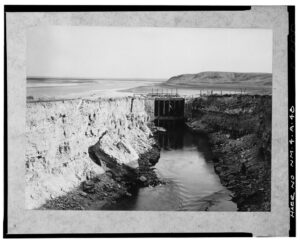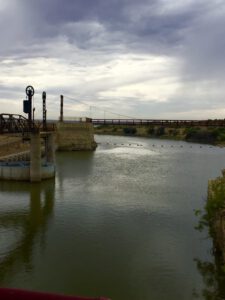Carlsbad Irrigation District (CID) was one of the earliest U.S. Reclamation Service projects and dates back to the turn of the 20th century. The town of Carlsbad, New Mexico, grew up around the project and the agriculture it enabled. The project has been updated several times over the years—notably with the Brantley Dam and Reservoir in the late 1980s—but much of its infrastructure is a century old.
In this interview, CID Manager Dale Ballard speaks with Irrigation Leader Editor-in-Chief Kris Polly about the challenges of updating and maintaining this historic system in the desert landscape of New Mexico.
Kris Polly: Please tell us about your background.
Dale Ballard: I was born and raised in Eddy County, where CID lies. My family has been in the agriculture business there for four generations. I completed a career in education: I spent 23 years in the classroom as a teacher and 10 years as a building principal. I retired in 2014 and accepted this position with the district. I did not have any experience in water management; the transferable skills were creating and balancing budgets and working with the State of New Mexico through the Department of Finance. Of course, I was familiar with the district, because even though I did not go into the farming business, my family was involved in it and I grew up working on farms in the area. I’ve been at the irrigation district for 5 years now, and I’m actually set to retire at the end of this water season, on October 31, 2019.
Kris Polly: Please tell us about CID and its history.
Dale Ballard: CID was one of the first projects of the U.S. Reclamation Service, later the Bureau of Reclamation, and was built at the turn of the 20th century, when
Teddy Roosevelt was president. It started as a land speculation company and was founded by pioneers including Charles W. Greene, Robert Weems Tansill, and James John Hagerman. They thought they would be able to make a lot of money by developing farmland. However, the Pecos River system is flashy, and they weren’t prepared for the flooding that occurred in the late 1800s and early 1900s. After it wiped them out two or three times, they went to Reclamation, which took over the project after the flood of 1904. Reclamation rebuilt Avalon Reservoir and then did some work on McMillan Reservoir. In 1935, another reservoir was built upstream around Fort Sumner to help it hold water for Carlsbad and to create a better supply for the Fort Sumner Irrigation District. In the 1980s, McMillan Dam was beginning to silt in, so Reclamation built Brantley Dam in the to replace it. Brantley came online in the late 1980s and McMillan Dam was breached. Those are the primary components of the system we have today. There is another dam, Santa Rosa Dam, which was built by the U.S. Army Corps of Engineers. It is not a Reclamation dam—it’s just for flood control on the upper Pecos—but it does store water for us.
Kris Polly: Please tell us about the district’s services today.

Dale Ballard: We’ve got about 650 users who range from a quarter of an acre to thousands of acres. We service a little over 25,000 acres of water rights attached to land. On any given year, there are probably 16,000–17,000 acres being farmed in the district.
During the 1990s, the New Mexico Interstate Stream Commission (ISC) was leasing water in order to meet the state line delivery requirements to Texas under the 1947 Pecos River Compact. ISC later purchased about a little over 4,600 acres of land within CID. The water that would have been diverted for farm delivery to the land ISC purchased is instead diverted directly into the Pecos River for state line delivery. However, ISC does not require CID to divert water to the Pecos River in extremely dry years when the amount of water available for delivery to CID farms is less than 50,000 acre-feet. ISC also does not take delivery of its water in years in which the river master determines that state line delivery has met a certain threshold. In the years ISC does not take delivery of its water, that water is available for use by CID farmers.
Kris Polly: What are the main crops in your area?
Dale Ballard: Alfalfa and cotton are the main ones. Pecan orchards have started to pop up in the district over the last 20 years. There are also grains, corns, and other specialty crops grown for particular markets, but alfalfa and cotton continue to be the main crops.
Kris Polly: Is your water all surface water?

Dale Ballard: Yes. However, up until the early 1970s, the farmers were able to apply to the state engineer for permission to drill supplemental wells for years when there was not a full allotment. Not every farm has supplemental wells, however. On the southern end of our district, there are also about 1,000 acres that are supplemented with water from the Black River, which is a tributary of the Pecos. Other than that, it’s all Pecos River water.
Kris Polly: What is your total diversion?
Dale Ballard: The total number of acres that we have rights to is 25,055. Depending on what’s in the reservoirs each year, we can allot up to 3.697 acre-feet per acre.
Kris Polly: How many employees does the district have?
Dale Ballard: We have operations and maintenance (O&M) agreements with Reclamation for Avalon, Sumner, and Brantley Dams and Reservoirs. We have 6 employees for those sites. We have about 25 more employees if we’ve got full crew. Over the last couple of years, with the oil and gas boom down here, we have been struggling to compete with the oil and gas industries on wages, so we haven’t had a full crew for several years. We have about 30 employees if we are fully staffed.
Kris Polly: What are your district’s top issues and priorities today?

Dale Ballard: One of the dams that we have an O&M contract for, Avalon Dam, is about 115 years old. Sumner Dam was completed in 1935, so it’s approaching 100 years of age. The newest Reclamation dam that we have an O&M agreement for is Brantley, which came online in the late 1980s, I think in 1988. The aging infrastructure is a huge issue. When it comes to repairs, most of our money comes from assessments that we charge the farmers. If we raise our assessment by $1 per acre, we raise $25,000. That just doesn’t go very far when you’re talking about major projects like replacing cylinder or radial gates that are over 100 years old. The radial gates for flood control at Sumner are close to 100 years old. It is a big challenge to try to keep those up and running and up to Reclamation’s expectations.
Kris Polly: What kind of funding strategies have you looked into?
Dale Ballard: We’ve looked into WaterSMART grants from Reclamation. We’ve also just completed a couple of projects using a product called Aqualastic to repair sections of our main canal. Every winter, we try to address the needs of the system that we’ve identified during the water season. We’re partnering with Reclamation to work on the cylinder gates at Avalon, since their flood control function was made obsolete when Brantley was built upstream. We plan to reengineer and remove those gates and do something different with the structure. Each year, we try to chip away at Reclamation’s O&M recommendations as we are able. We try to keep those needs to a minimum and to keep everything in operating shape. It’s always a challenge to work on a structure that’s 100 years old. It’s like working on the plumbing in an old house: You want to repair a faucet and end up having to replace it, then you have to replace the drywall, and then there’s flooding inside the wall. You just can’t get replacement parts for some of these old structures.
Kris Polly: Have you been affected by drought in recent years?
Dale Ballard: The three years prior to my arrival—2011, 2012, and 2013—were all really dry. We had two big rain events in 2014, some of the water from which was caught by the reservoirs. We have actually had full allotment for the last 5 years, even though the drought has affected us. Actually, a big part of the reason that we’ve been able to have our full allotment is because of ISC, which I spoke about earlier. ISC bought land so that the water could be used for state line delivery, but when those two rain events occurred in 2013 and 2014, a lot of water went across the state line, creating an overage, or credit, you might say, with Texas. As a result, ISC has not taken delivery of its water for the last 3 years. That extra water has allowed us to supplement our supply, so we have been able to meet our allotment.
With the ISC purchase of 4,600 acres of land in the district and the fact that some farmers are letting land fallow, there are 5,000–10,000 acres each year that are not being cultivated. With this much land not being farmed, sometimes there are not enough orders to maintain a continuous flow in our main canal. When orders drop below 50–70 cubic feet per second, carriage losses go up to 40–50 percent, which is very inefficient. This forces a shutdown of delivery until enough orders are placed to reduce the carriage losses back under a threshold of 25–35 percent. When this happens, farmers do not always get water as quickly as they would like. Crops suffer during these periods.
Kris Polly: What is your vision for the future?
Dale Ballard: My hope is that within the next 30–60 days, the district is able to find a young, ambitious person who is willing to accept these challenges and to continue to try to rebuild this infrastructure and make it a viable system. The town of Carlsbad was built over 100 years ago around this irrigation system and the farming that surrounds it. There’s a lot of history there. I hope that it’s able to continue long into the future.
Dale Ballard is the manager of the Carlsbad Irrigation District. He can be contacted at dale.ballard@cidistrict.com or at (575) 236-6390.
